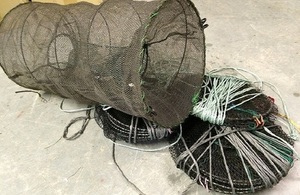Illegal crayfish traps recovered from North East river
Environment Agency fisheries officers remove four traps from the River Wear in County Durham.

Environment Agency fisheries officers are investigating after four illegal crayfish traps were recovered from the River Wear.
On Wednesday night, Fisheries Enforcement Officers on patrol acted on information about four traps in the river at Shincliffe, County Durham.
They seized them and are now carrying out further enquiries.
Now experts are reminding people that there is a ban on trapping crayfish in the North East to protect the native population of white clawed crayfish.
The invasive American signal crayfish carries a fungal disease which is deadly to the native population.
Signal crayfish eat their own young, which means if adults are trapped and removed there aren’t enough to control the population, which can lead to increases in numbers.
Unregulated trapping can also lead to people spreading the disease to areas where the white clawed crayfish still populate, and illegal traps can be a danger to other wildlife and protected species.
Only a handful of trapping requests are granted in the North East, and that’s for research purposes.
Kev Summerson, Fisheries Enforcement Technical Specialist for the North East, said:
There are still populations of our indigenous white clawed crayfish in North East rivers, and this is a protected species which we work hard to safeguard.
Fishing or trapping crayfish in our rivers is illegal and people need to be aware that anyone involved in such activity will potentially face enforcement action.
Anyone who uses our waterways for work, activities or sports is asked to follow Check Clean Dry:
Check - check your equipment and clothing for living organisms. Pay particular attention to areas that are damp or hard to inspect.
Clean - clean and wash all equipment, footwear and clothes thoroughly. If you do come across any organisms, leave them at the water body where you found them.
Dry - Dry all equipment and clothing - some species can live for many days in moist conditions. Make sure you don’t transfer water elsewhere.